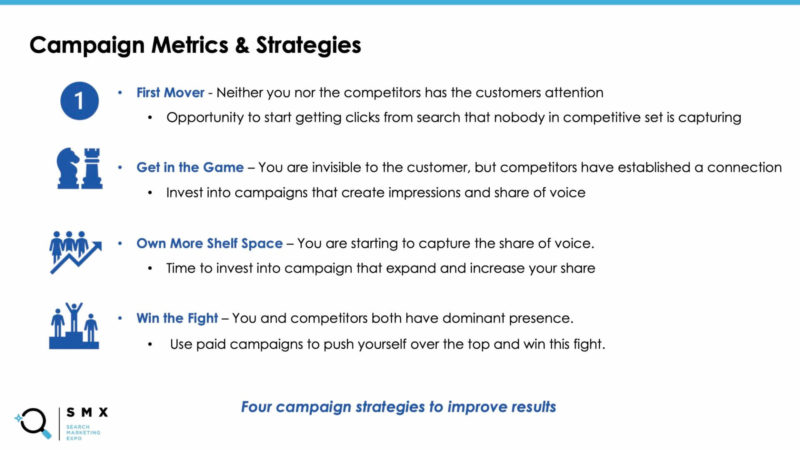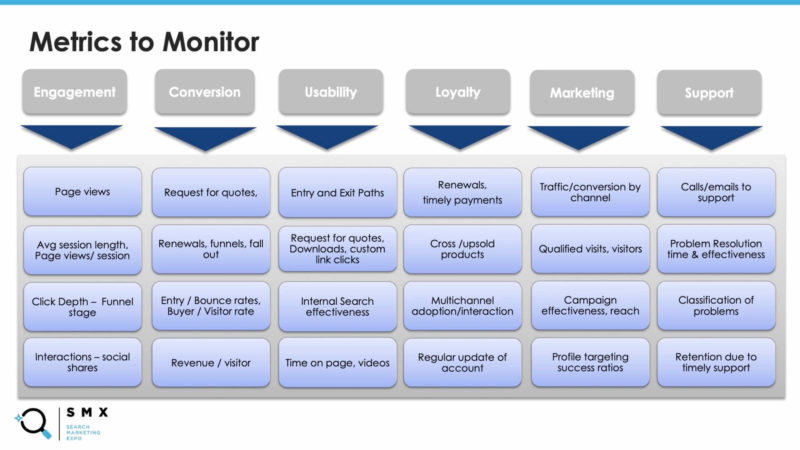It all comes down to what stage your business is at, its goals, and identifying the supporting metrics that can help you get there.
Key performance indicators (KPIs) help us cut through the noise and get right to what matters most to our businesses. However, there are many factors to consider before elevating a metric into the almighty KPI slot. And, even after you’ve decided which KPIs will guide your strategic decisions, there are supporting metrics that can help ensure your business is on track to meet your KPI targets.
Not all metrics are KPIs
Although both KPIs and metrics are used to measure some aspect of performance, and KPIs fall within the greater definition of a metric, the distinction is important because KPIs are more significant to the overall success of your campaigns. At SMX Virtual in December, Tanu Javeri, global digital analytics enablement lead at IBM, defined metrics and KPIs as follows:
- Metric: A quantifiable measure that is used to track and assess the status of a specific process. In other words, a measurement you record to track some aspect of your business activity.
- KPI: This is also a measurement, but it’s related to a specific strategic business goal and reflects how successful your business is at achieving that goal.
“Metrics reflect how successfully an activity is completed to support the KPI,” Javeri said, “Simply put, KPIs are strategic, while metrics are tactical.”
Determining the right KPI for you
Understand what stage of growth your business is in. Knowing which stage of maturity your business is at and its current goals are key to determining your KPIs (there may be more than one).
Ask yourself: Are you working towards building greater awareness or capturing more conversions? Is your business sensitive to external factors such as market demand or seasonality? If you’re a startup looking to crowdsource funding for a new consumer product, your return on ad spend to get in front of potential backers is probably more important than time spent on-page.

Ask yourself the mandatory questions. Many metrics may seem equally important to your goals, but your KPI must cut through the noise. To help single out that KPI, ask yourself the following:
- What is a measurable activity that can get you closer to your goals?
- How can you measure how effective you are at that activity?
- What numbers signify recent or long-term business performance?
It’s important to delineate between short and long term goals — think about how frequently you need to evaluate performance or make changes, as this interval will depend on the nature of your business and the sector it operates in. For example, monthly recurring revenue is probably more important to a company like BarkBox than it is for, say, Spirit Halloween.
Narrowing down your list. Shifting priorities in one direction means that focus may be taken away from other areas, so consider how these new goals may affect your operations before formalizing your KPIs. For example, making your organic search rankings your main KPI may downplay the importance of your social channels, which can result in siloing your social teams.
As you narrow down your list of potential KPIs, remember that the ones you ultimately commit to should be significant, contribute to an overall objective, and thus, translate to business benefits. And, from an organizational standpoint, having an easily understood set of KPIs can help you align goals across teams.
Bolstering your KPIs
A metric for each part of the user journey. “Breaking down the user journey, phase by phase, aligning each step with a goal, and restructuring your touch points accordingly are essential steps towards maximizing customer success,” Javeri said. This process can also help you monitor your various marketing channels and better appreciate how those channels affect your KPIs.

This process also helps you correct course by identifying extraneous steps or bottlenecks that your customers may be encountering. Once these issues are identified, you can take steps to remedy them by streamlining your journey or providing content or services that helps them along.
Take, for example, a services page for a food delivery platform that gets a lot of visitors but has a high bounce rate; safety might be a top priority for your customers, so adding details about contactless delivery and the personal protective equipment your employees use might have a positive impact.
 100vw, 800px” data-lazy-src=”https://searchengineland.com/wp-content/seloads/2021/01/smxv2020-tanujaveri_s12-800×450.jpg” /><figcaption>Source: Tanu Javeri.</figcaption></figure>
<p>Funnel analysis can also help you spot barriers that are inhibiting conversions so that you can take corrective action. For example, if your renewal rates are especially low, that might indicate an issue with the long-term durability of your product or the customer service you’re providing. Additionally, funnel analysis can also highlight what’s working well so that you can be more strategic with your marketing decisions.</p>
<p><strong>Lagging and leading indicators.</strong> Other indicators can and should be used to inform decisions that will strengthen your KPIs. One approach is to break out other important metrics into two buckets: “lagging” and “leading” indicators.</p>
<p>Lagging indicators tell you about what has already occurred and provide you with some insight into the current state of your business: revenue from last quarter, number of paying event attendees, and feedback scores are examples of lagging indicators. This data tends to be easier to measure because it’s rooted in the past, and it can be used as a benchmark for future campaigns or projects.</p>
<p>Leading indicators, such as contact form fills, number of clients that have committed to longer contracts, and site traffic, can help you predict future performance. These types of indicators are useful for helping you gauge the likelihood that you’ll reach your target KPIs.</p>
<p>Let’s tie this together with another example: You’ve decided that the main KPI for your B2C e-commerce site will be average revenue per order. A leading indicator might be your number of engaged email subscribers. You could send them coupons for 10% off of their order of $150 to encourage them to spend more, which would ideally boost your open rates as well as your main KPI. Your customer loyalty rate, which could be a lagging indicator, can help signal when you might need to source feedback and reevaluate your user journey so that customers are likely to spend more when they do shop with you.</p>
<p><strong>KPIs keep you data-driven. </strong>Solid KPIs keep data at the forefront of your business decision-making instead of relying on hunches or feelings. You can establish KPIs at all levels of your business — from individual contributor OKRs to companywide goals.</p>
</div>
</div>
</div><!-- .entry-content -->
<footer class=)


